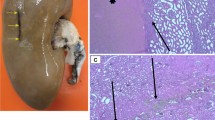Abstract
Introduction
High irrigation rates are commonly used during ureteroscopy and can increase intrarenal pressure (IRP) substantially. Concerns have been raised that elevated IRP may diminish renal blood flow (RBF) and perfusion of the kidney. Our objective was to investigate the real-time changes in RBF while increasing IRP during Ureteroscopy (URS) in an in-vivo porcine model.
Methods
Four renal units in two porcine subjects were used in this study, three experimental units and one control. For the experimental units, RBF was measured by placing an ultrasonic flow cuff around the renal artery, while performing ureteroscopy in the same kidney using a prototype ureteroscope with a pressure sensor at its tip. Irrigation was cycled between two rates to achieve targeted IRPs of 30 mmHg and 100 mmHg. A control data set was obtained by placing the ultrasonic flow cuff on the contralateral renal artery while performing ipsilateral URS.
Results
At high IRP, RBF was reduced in all three experimental trials by 10–20% but not in the control trial. The percentage change in RBF due to alteration in IRP was internally consistent in each porcine renal unit and independent of slower systemic variation in RBF encountered in both the experimental and control units.
Conclusion
RBF decreased 10–20% when IRP was increased from 30 to 100 mmHg during ureteroscopy in an in-vivo porcine model. While this reduction in RBF is unlikely to have an appreciable effect on tissue oxygenation, it may impact heat-sink capacity in vulnerable regions of the kidney.



Similar content being viewed by others
Data availability
The datasets generated during and/or analyzed during the current study are available from the corresponding author on reasonable request.
References
Sierra A, Corrales M, Kolvatzis M, et al: Real Time Intrarenal Pressure Control during Flexible Ureterorrenscopy Using a Vascular PressureWire: Pilot Study. J. Clin. Med. Res. 2022; 12. Available at: https://doi.org/10.3390/jcm12010147.
Jung H, Osther PJS (2015) Intraluminal pressure profiles during flexible ureterorenoscopy. Springerplus 4:373
Patel RM, Jefferson FA, Owyong M et al (2021) Characterization of intracalyceal pressure during ureteroscopy. World J Urol 39:883–889
Thomsen HS, Dorph S, Olsen S (1981) Pyelorenal backflow in normal and ischemic rabbit kidneys. Invest Radiol 16:206–214
Thomsen HS, Dorph S, Olsen S (1982) Pyelorenal backflow in rabbits following clamping of the renal vein and artery: radiologic and microscopic investigation. Acta Radiol Diagn 23:143–148
Hinman F, Redewill FH (1926) PYELOVENOUS BACK FLOW. JAMA 87:1287–1293
Boccafoschi C, Lugnani F (1985) Intrarenal reflux. Urol Res 13:253–258
Stenberg A, Bohman SO, Morsing P et al (1988) Back-leak of pelvic urine to the bloodstream. Acta Physiol Scand 134:223–234
Thomsen HS, Larsen S and Talner LB: Pyelorenal backflow during retrograde pyelography in normal and ischemic porcine kidneys. A radiologic and pathoanatomic study. Eur. Urol. 1982; 8: 291–297.
Kottooran C, Twum-Ampofo J, Lee J et al (2023) Evaluation of fluid absorption during flexible ureteroscopy in an in-vivo porcine model. BJU Int 131:213–218
Pedersen KV, Liao D, Osther SS et al (2012) Distension of the renal pelvis in kidney stone patients: sensory and biomechanical responses. Urol Res 40:305–316
Zhong W, Leto G, Wang L et al (2015) Systemic inflammatory response syndrome after flexible ureteroscopic lithotripsy: a study of risk factors. J Endourol 29:25–28
Kreydin EI, Eisner BH (2013) Risk factors for sepsis after percutaneous renal stone surgery. Nat Rev Urol 10:598–605
Hvistendahl JJ, Pedersen TS, Jørgensen HH et al (1996) Renal hemodynamic response to gradated ureter obstruction in the pig. Nephron 74:168–174
Balawender K: A Prospective Study of Renal Blood Flow during Retrograde Intrarenal Surgery. J. Clin. Med. Res. 2023; 12. Available at: https://doi.org/10.3390/jcm12083030.
Yazici CM, Akgul M, Ozcaglayan O et al (2021) Prospective Evaluation of Ipsilateral and Contralateral Renal Blood Flow During Retrograde Intrarenal Surgery. Urology 154:77–82
Dumbill R, Mellati A, Yang BD et al (2023) Ureterorenoscopy during normothermic machine perfusion: effect of varying renal pelvis pressure. BJU Int 131:50–52
Pallone TL, Edwards A, Mattson DL (2012) Renal medullary circulation Compr Physiol 2:97–140
Dalal R, Bruss ZS, Sehdev JS (2022) Physiology. StatPearls Publishing, Renal Blood Flow and Filtration
Ron Marom, Julie J. Dau, Timothy L. Hall, Khurshid R. Ghani, William W. Roberts: In-Vivo Thermal Tissue Mapping in a Porcine Model During Laser Activation. In: Engineering and Urology Society, 36th Annual Meeting. 2023.
Kalantarinia K, Belcik JT, Patrie JT et al (2009) Real-time measurement of renal blood flow in healthy subjects using contrast-enhanced ultrasound. Am J Physiol Renal Physiol 297:F1129–F1134
Glenny RW, Bernard S, Brinkley M (1993) Validation of fluorescent-labeled microspheres for measurement of regional organ perfusion. J Appl Physiol 74:2585–2597
Acknowledgements
The authors would like to acknowledge Professor J. Brian Fowlkes for loaning us the transonic flow measurement system.
Funding
Funding for this research was provided through a research grant from Boston Scientific.
Author information
Authors and Affiliations
Contributions
RM: project development, data collection, manuscript writing, and data analysis. WWR: manuscript writing/editing, data analysis, critical revision, and study management. JJD: manuscript editing. KRG: manuscript editing. TLH: manuscript editing.
Corresponding author
Ethics declarations
Conflict of interest
K.R.G. has consulting relationships with Boston Scientific, Ambu, Olympus, Coloplast, and Karl Storz. W.W.R. has a consulting relationship with Boston Scientific. R.M., J.J.D., and T.L.H. have no disclosures. The prototype ureteroscope used in this study was a concept device/technology, which was not available for sale at the time the study was conducted. Pre-clinical study results may not necessarily be indicative of clinical performance.
Ethics approval
All procedures performed in the study involving animal subjects were in accordance with the ethical standards of the institutional research committee and were approved by the University of Michigan’s Institutional Animal Care and Use Committee (IACUC).
Additional information
Publisher's Note
Springer Nature remains neutral with regard to jurisdictional claims in published maps and institutional affiliations.
Rights and permissions
About this article
Cite this article
Marom, R., Dau, J.J., Ghani, K.R. et al. Change in renal blood flow in response to intrarenal pressure alterations induced by ureteroscopy in an in-vivo porcine model. World J Urol 41, 3181–3185 (2023). https://doi.org/10.1007/s00345-023-04641-3
Received:
Accepted:
Published:
Issue Date:
DOI: https://doi.org/10.1007/s00345-023-04641-3




